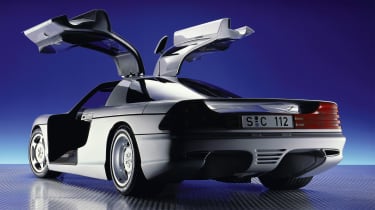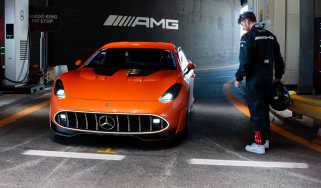Mercedes-Benz C112 – dead on arrival
Despite strong demand, this V12-powered supercar was denied production – but its legacy lives on

This was one of those occasional times when Mercedes-Benz slapped its technology tackle onto the table. Revealed at the 1991 Frankfurt motor show, the name of the C112 signalled it as spiritual successor to the C111 rotary- and diesel-powered test cars from the 1960s and ’70s, but the technology within it reflected a decade of R&D progress since those bright orange record setters were retired.
The C112 had active body control using hydraulic rams on top of the springs to help repel roll, dive and squat. It had rear-wheel steering, grandly labelled a ‘cybernetic’ system by Mercedes, which turned contra or parallel to the front wheels depending on speed. It had an active air brake which popped up to 45 degrees and, according to Mercedes, reduced the 190-0mph stopping distance by a useful 330 feet. Most remarkably, the C112 had an active aero system that hydraulically deployed a front spoiler and a rear wing and could react in a tenth of a second to increase downforce when the car’s multiple G-force sensors detected a loss of grip in a corner. Why it wasn’t already providing enough downforce to stop you losing grip in the first place isn’t clear. As well as this centrally controlled suite of active dynamic aids the C112 came with radar cruise control, tyre pressure monitoring and traction control, commonplace features now but 30 years ago more like distant pings from the future.
The whole thing was powered by a 6-litre, 403bhp V12 driving the rear wheels through a six-speed manual gearbox, contained within an aluminium monocoque skinned with ally and Kevlar panels to a design intended to remind people of the Sauber-built Mercedes Group C racers that had taken the World Sportscar Championship titles in 1989 and ’90. But where the C11 racer’s door flopped forward when open, the C112 had gullwings like an original 300 SL, or indeed the C111.
> Jaguar F-type – dead on arrival
This was a mind-bogglingly advanced machine for its time but it was blatantly engineered with an eye on the showroom. Its V12, the M120 unit from the 600 SEL launched earlier in 1991, was capable of meeting emissions standards all around the world, and the car was designed to meet global safety standards too, with ABS, airbags, and regular seatbelts neatly integrated into its electric seats. The show car, beautifully built by Turin-based carrozzeria Coggiola, certainly looked ready for production, to the extent that 700 people contacted Mercedes after its debut and demanded to place an order, despite no mention of a production schedule or price.
It was subsequently reported that Merc management gave serious thought to signing off the C112 for public consumption, maybe even getting their race partners at Sauber to build it, but ultimately realised it was a risk they couldn’t take. This was the early ’90s and the world was plunging into a recession that would do no favours to high-priced, low-volume supercars, as Jaguar and Bugatti were about to discover. Plus, Merc was already smarting from launching the hefty W140 S-class, which was late, over-budget and suddenly looked horribly out of step with the times. An ostentatious gullwinged flagship was impossible to justify and the C112 remained a one-off that lives to this day in the factory museum. Almost all of its technology has ended up in other Mercedes cars, however, and its V12 eventually became a mid-engined superstar as the motor in the original Pagani Zonda.
This story was first featured in evo issue 289.






